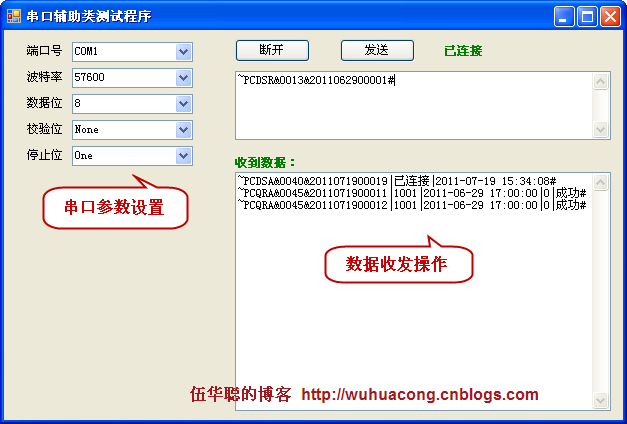C# 串口开发总结
开发C#相关的项目有很多年了,一直没有接触串口的开发,近期由于工作的需要,需要了解熟悉对硬件串口的开发,通过对串口的深入了解,串口也不再是什么神秘的东西,利用SerailPort组件,对串口的各种操作也非常的方便,由于本人总是喜欢把一些常用的东西封装成可供重复利用的类库,因此,阅百家代码,提炼总结优化,把对串口的操作封装成一个公用的类库,应付日常的串口编程开发,也算是工作的一个阶段性总结吧。
先上图,了解串口的一些基本的东西,并逐步介绍相关的知识。
微软在 .NET FrameWork2.0中对串口通讯进行了封装,我们可以在.net2.0及以上版本开发时直接使用SerialPort类对串口进行读写操作。
SerialPort类的属性主要包括:
1)串口名称(PortName)
2)波特率(BaudRate)
3)数据位 DataBits
4)停止位 StopBits
5)奇偶校验 Parity
SerialPort类的事件主要包括:
DataReceived:用于异步接收串口数据事件
ErrorReceived:错误处理事件
SerialPort类的方法主要包括:
Open();Close();Read();Write()、DiscardInBuffer()、DiscardOutBuffer()等
从上面的测试例子图中,我们可以看到,一般对串口的操作,需要提供串口号、波特率、数据位、停止位、奇偶校验的参数,用来构造一个串口操作类,以便实现具体的串口操作,而这些参数有的是系统内置的枚举参数,我们可以通过遍历枚举对象来绑定下来列表(如停止位、奇偶校验);但有些参数却不是系统内置的枚举类型,例如波特率、数据位等,而且对这些参数操作也是串口开发经常用到的,因此,第一步,我对这些参数的绑定做了一个简单的封装。
1、先构造波特率、数据位这两个枚举对象,方便实际操作。
///
/// 串口数据位列表(5,6,7,8)
///
public enum SerialPortDatabits : int
{
FiveBits = 5,
SixBits = 6,
SeventBits = 7,
EightBits = 8
}
///
/// 串口波特率列表。
/// 75,110,150,300,600,1200,2400,4800,9600,14400,19200,28800,38400,56000,57600,
/// 115200,128000,230400,256000
///
public enum SerialPortBaudRates : int
{
BaudRate_75 = 75,
BaudRate_110 = 110,
BaudRate_150 = 150,
BaudRate_300 = 300,
BaudRate_600 = 600,
BaudRate_1200 = 1200,
BaudRate_2400 = 2400,
BaudRate_4800 = 4800,
BaudRate_9600 = 9600,
BaudRate_14400 = 14400,
BaudRate_19200 = 19200,
BaudRate_28800 = 28800,
BaudRate_38400 = 38400,
BaudRate_56000 = 56000,
BaudRate_57600 = 57600,
BaudRate_115200 = 115200,
BaudRate_128000 = 128000,
BaudRate_230400 = 230400,
BaudRate_256000 = 256000
}
2、对常用的参数下拉列表绑定做一个封装。
///
/// 设置串口号
///
///
public static void SetPortNameValues(ComboBox obj)
{
obj.Items.Clear();
foreach (string str in SerialPort.GetPortNames())
{
obj.Items.Add(str);
}
}
///
/// 设置波特率
///
public static void SetBauRateValues(ComboBox obj)
{
obj.Items.Clear();
foreach (SerialPortBaudRates rate in Enum.GetValues(typeof(SerialPortBaudRates)))
{
obj.Items.Add(((int)rate).ToString());
}
}
///
/// 设置数据位
///
public static void SetDataBitsValues(ComboBox obj)
{
obj.Items.Clear();
foreach (SerialPortDatabits databit in Enum.GetValues(typeof(SerialPortDatabits)))
{
obj.Items.Add(((int)databit).ToString());
}
}
///
/// 设置校验位列表
///
public static void SetParityValues(ComboBox obj)
{
obj.Items.Clear();
foreach (string str in Enum.GetNames(typeof(Parity)))
{
obj.Items.Add(str);
}
}
///
/// 设置停止位
///
public static void SetStopBitValues(ComboBox obj)
{
obj.Items.Clear();
foreach (string str in Enum.GetNames(typeof(StopBits)))
{
obj.Items.Add(str);
}
}
这样我们在窗体界面代码中,绑定相关参数的数据源就很方便了,如下所示。
private void Form1_Load(object sender, EventArgs e)
{
BindData();
}
private void BindData()
{
//绑定端口号
SerialPortUtil.SetPortNameValues(txtPort);
txtPort.SelectedIndex = 0;
//波特率
SerialPortUtil.SetBauRateValues(txtBaudRate);
txtBaudRate.SelectedText = "57600";
//数据位
SerialPortUtil.SetDataBitsValues(txtDataBits);
this.txtDataBits.SelectedText = "8";
//校验位
SerialPortUtil.SetParityValues(txtParity);
this.txtParity.SelectedIndex = 0;
//停止位
SerialPortUtil.SetStopBitValues(txtStopBit);
this.txtStopBit.SelectedIndex = 1;
this.btnSend.Enabled = isOpened;
}
3、 为了方便构造封装的窗口类,提供了两个不同类型参数的串口辅助类构造函数,一个可以使用枚举参数,一个使用字符串参数(最终转换为枚举参数对象),如下所示。使用枚举对象,不需要记住不同参数应该填写那些值,只需要从枚举中选择即可,方便又直观。
///
/// 参数构造函数(使用枚举参数构造)
///
/// 波特率
/// 奇偶校验位
/// 停止位
/// 数据位
/// 串口号
public SerialPortUtil(string name, SerialPortBaudRates baud, Parity par, SerialPortDatabits dBits, StopBits sBits)
{
_portName = name;
_baudRate = baud;
_parity = par;
_dataBits = dBits;
_stopBits = sBits;
comPort.DataReceived += new SerialDataReceivedEventHandler(comPort_DataReceived);
comPort.ErrorReceived += new SerialErrorReceivedEventHandler(comPort_ErrorReceived);
}
///
/// 参数构造函数(使用字符串参数构造)
///
/// 波特率
/// 奇偶校验位
/// 停止位
/// 数据位
/// 串口号
public SerialPortUtil(string name, string baud, string par, string dBits, string sBits)
{
_portName = name;
_baudRate = (SerialPortBaudRates)Enum.Parse(typeof(SerialPortBaudRates), baud);
_parity = (Parity)Enum.Parse(typeof(Parity), par);
_dataBits = (SerialPortDatabits)Enum.Parse(typeof(SerialPortDatabits), dBits);
_stopBits = (StopBits)Enum.Parse(typeof(StopBits), sBits);
comPort.DataReceived += new SerialDataReceivedEventHandler(comPort_DataReceived);
comPort.ErrorReceived += new SerialErrorReceivedEventHandler(comPort_ErrorReceived);
}
构造函数做好了,就很方便在实际的窗体界面函数中构造串口实例了,如下使用代码所示:
private void btnConnect_Click(object sender, EventArgs e)
{
try
{
if (serial == null)
{
try
{
string portname = this.txtPort.Text;
SerialPortBaudRates rate = (SerialPortBaudRates)Enum.Parse(typeof(SerialPortBaudRates), this.txtBaudRate.Text);//int.Parse(this.txtBaudRate.Text);
SerialPortDatabits databit = (SerialPortDatabits)int.Parse(this.txtDataBits.Text);
Parity party = (Parity)Enum.Parse(typeof(Parity), this.txtParity.Text);
StopBits stopbit = (StopBits)Enum.Parse(typeof(StopBits), this.txtStopBit.Text);
//使用枚举参数构造
//serial = new SerialPortUtil(portname, rate, party, databit, stopbit);
//使用字符串参数构造
serial = new SerialPortUtil(portname, this.txtBaudRate.Text, this.txtParity.Text, this.txtDataBits.Text, this.txtStopBit.Text);
serial.DataReceived += new DataReceivedEventHandler(serial_DataReceived);
}
catch (Exception ex)
{
MessageBox.Show(ex.Message);
serial = null;
return;
}
}
if (!isOpened)
{
serial.OpenPort();
btnConnect.Text = "断开";
}
else
{
serial.ClosePort();
serial = null;
btnConnect.Text = "连接";
}
isOpened = !isOpened;
this.btnSend.Enabled = isOpened;
this.lblTips.Text = isOpened ? "已连接" : "未连接";
}
catch (Exception ex)
{
this.lblTips.Text = ex.Message;
MessageBox.Show(ex.Message);
}
}4、对串口数据的发送以及串口的一些基本操作进行简单封装,方便辅助类对串口进行相关操作。
///
/// 端口是否已经打开
///
public bool IsOpen
{
get
{
return comPort.IsOpen;
}
}
///
/// 打开端口
///
///
/// 关闭端口
///
public void ClosePort()
{
if (comPort.IsOpen) comPort.Close();
}
///
/// 丢弃来自串行驱动程序的接收和发送缓冲区的数据
///
public void DiscardBuffer()
{
comPort.DiscardInBuffer();
comPort.DiscardOutBuffer();
}
///
/// 写入数据
///
///
public void WriteData(string msg)
{
if (!(comPort.IsOpen)) comPort.Open();
comPort.Write(msg);
}
///
/// 写入数据
///
/// 写入端口的字节数组
public void WriteData(byte[] msg)
{
if (!(comPort.IsOpen)) comPort.Open();
comPort.Write(msg, 0, msg.Length);
}
///
/// 写入数据
///
/// 包含要写入端口的字节数组
/// 参数从0字节开始的字节偏移量
/// 要写入的字节数
public void WriteData(byte[] msg, int offset, int count)
{
if (!(comPort.IsOpen)) comPort.Open();
comPort.Write(msg, offset, count);
} 6、接收数据的还原
这样基本上就对串口封装的差不多了,不过还有一个重要的操作就是对串口的数据进行接收,并进行处理。由于串口获取数据不是一次性完整的获取的,可能会被拆分为好几段,因此,如何还原接收到的数据也就是一个值得注意的问题,这个最好能根据协议来确定,如我的协议基本上是以“~”符号开始,以“#”符号结束,因此我对协议数据的还原,就有可依据的准则。
1)首先要构造一个数据处理的代理,和一个数据处理的事件参数类,如下所示。
public class DataReceivedEventArgs : EventArgs
{
public string DataReceived;
public DataReceivedEventArgs(string m_DataReceived)
{
this.DataReceived = m_DataReceived;
}
}
public delegate void DataReceivedEventHandler(DataReceivedEventArgs e); 2)然后构造一个数据接收和错误处理的事件,如下所示:
///
/// 完整协议的记录处理事件
///
public event DataReceivedEventHandler DataReceived;
public event SerialErrorReceivedEventHandler Error; 3)在构造函数添加相关的事件处理,如下所示:
///
/// 参数构造函数(使用枚举参数构造)
///
/// 波特率
/// 奇偶校验位
/// 停止位
/// 数据位
/// 串口号
public SerialPortUtil(string name, SerialPortBaudRates baud, Parity par, SerialPortDatabits dBits, StopBits sBits)
{
_portName = name;
_baudRate = baud;
_parity = par;
_dataBits = dBits;
_stopBits = sBits;
comPort.DataReceived += new SerialDataReceivedEventHandler(comPort_DataReceived);
comPort.ErrorReceived += new SerialErrorReceivedEventHandler(comPort_ErrorReceived);
} 4)实现对数据的接收和错误的处理
///
/// 结束符比特
///
public byte EndByte = 0x23;//string End = "#";
///
/// 数据接收处理
///
void comPort_DataReceived(object sender, SerialDataReceivedEventArgs e)
{
//禁止接收事件时直接退出
if (ReceiveEventFlag) return;
#region 根据结束字节来判断是否全部获取完成
List _byteData = new List();
bool found = false;//是否检测到结束符号
while (comPort.BytesToRead > 0 || !found)
{
byte[] readBuffer = new byte[comPort.ReadBufferSize + 1];
int count = comPort.Read(readBuffer, 0, comPort.ReadBufferSize);
for (int i = 0; i < count; i++)
{
_byteData.Add(readBuffer[i]);
if (readBuffer[i] == EndByte)
{
found = true;
}
}
}
#endregion
//字符转换
string readString = System.Text.Encoding.Default.GetString(_byteData.ToArray(), 0, _byteData.Count);
//触发整条记录的处理
if (DataReceived != null)
{
DataReceived(new DataReceivedEventArgs(readString));
}
}
///
/// 错误处理函数
///
void comPort_ErrorReceived(object sender, SerialErrorReceivedEventArgs e)
{
if (Error != null)
{
Error(sender, e);
}
} 在数据的接收还原中,我们用到了EndByte的变量,这个变量是协议数据的结束字符,如果检测到有这个字符的,就表明收到了一条完整的协议,可以把收到的字节数组组装成文本字符串,然后交给委托事件进行处理即可。在外部的宿主程序中,当有数据收到的时候,辅助类会通知其对数据进行处理,如我们在宿主程序中绑定处理代码如下所示:
void serial_DataReceived(DataReceivedEventArgs e)
{
this.txtReceived.Invoke(new MethodInvoker(delegate
{
this.txtReceived.AppendText(e.DataReceived + Environment.NewLine);
}));
}这样,一旦收到一条完整的协议,界面上就会在文本框中增加一行数据,如前面的图所示